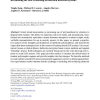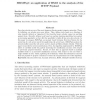21 search results - page 3 / 5 » Machine learning attacks against the Asirra CAPTCHA |
145
click to vote
ICDCS
2012
IEEE
13 years 2 months ago
2012
IEEE
—Virtual coordinate systems (VCS) provide accurate estimations of latency between arbitrary hosts on a network, while conducting a small amount of actual measurements and relying...
105
click to vote
IMC
2009
ACM
15 years 6 months ago
2009
ACM
Statistical machine learning techniques have recently garnered increased popularity as a means to improve network design and security. For intrusion detection, such methods build ...
100
click to vote
ML
2010
ACM
14 years 10 months ago
2010
ACM
Current trends demonstrate an increasing use of polymorphism by attackers to disguise their exploits. The ability for malicious code to be easily, and automatically, transformed in...
107
Voted
JMLR
2010
14 years 6 months ago
2010
Zero-days attacks are one of the most dangerous threats against computer networks. These, by definition, are attacks never seen before. Thus, defense tools based on a database of ...
91
Voted
SP
2006
IEEE
15 years 5 months ago
2006
IEEE
Attackers and defenders of computer systems both strive to gain complete control over the system. To maximize their control, both attackers and defenders have migrated to low-leve...


